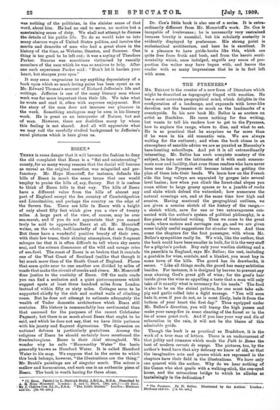ESSEX.*
THERE is some danger that it will become the fashion to deny the old complaint that Essex is a "flat and uninteresting" county, for so many wrong reasons that the denial will become as unreal as the original assertion was misguided and per- functory. Mr. Hope Moncrieff, for instance, defends the hills of Essex in much the same terms that one would 'employ to praise the hills of, say, Surrey. But it is useless to think of Essex hills in that way. The hills of Essex have a different value from the bills of almost any part of England except the fen country of Cambridgeshire and Lincolnshire, and perhaps the country on the edge of the Severn Sea. There are hills in Essex with a height of only about fifty feet which give you a view of twenty miles. A large part of the view, of course, may be over sea-marsh, and if you do not appreciate that you cannot truly be said to appreciate Essex at all. Mr. Moncrieff writes, on the whole, half-heartedly of the flat sea fringes. But these have a wonderful positive beauty of their own, with their low tones, their shining atmosphere, their frequent mirages (so that it is often difficult to tell where sky meets sea), and the solemn dissonance of the wild and savage cries of sea-fowl. The coast of Essex is so broken that it reminds one of the West Coast of Scotland (unlike that though it -be) much more than of the South Coast of England. Places that seem quite near to one another are divided by miles of 'roads that make the circuit of creeks and rivers. Mr. Moncrieff 'does justice to the rusticity of Essex. Off the main roads you can find a seclusion and a quiet picturesqueness which
• suggest spots at least three hundred miles from London instead of within fifty or sixty miles. Cottages seem to be supported chiefly by the rich and matted walls of climbing roses. But he does not attempt to estimate adequately the wealth of Tudor domestic architecture which Essex still contains. His history is commendably less sentimental than that assumed for the purposes of the recent Colchester • Pageant ; but there is so much about Essex that ought to be said, and which be does not say, that we have little patience with his jaunty and flagrant digressions. The digression on national defence is particularly gratuitous. Among the 'religions of Essex he should certainly have mentioned the Swedenborgians. Essex is their chief stronghold. We wonder why he calls " Ham worthy Water" the basin generally known as Bamford Water. It is called Hamford Water in his map. We suppose that in the series to which this book belongs, however, "the illustrations are the thing." Mr. Bruhl's paintings are of singular merit. The colour is • mellow and harmonious, and each one is an authentic piece of Essex. The book is worth having for these alone,
* (1) Eases:, Painted by L. Burleigh Bruhl, A.B.C.A., JIMA. Described by A. IL Hope Moncrielf. London: A. and C. Black. POs. net.]—(2) Essex. ' Hy J. Charles Cox, LL.D., F.S.A. "The Little Guides." London : Methuen and Co. U.s. 6cl. net..j Dr. Cox's little book is also one of a series. It is extra- ordinarily different from Mr. Moncrieff's work. Dr. Cox is incapable of irrelevance ; be is necessarily very restrained because brevity is essential, but his scholarly austerity is evidently displayed by preference. His strong point is ecclesiastical architecture, and here he is excellent. It is a pleasure to have guide-books like this, which are quite free from froth and bosh, and from the heroic .senti- mentality which, once indulged, engulfs any sense of pro- portion the writer may have begun with, and leaves the reader with so many impressions that he is in fact left with none.














































 Previous page
Previous page